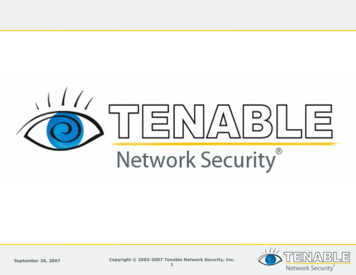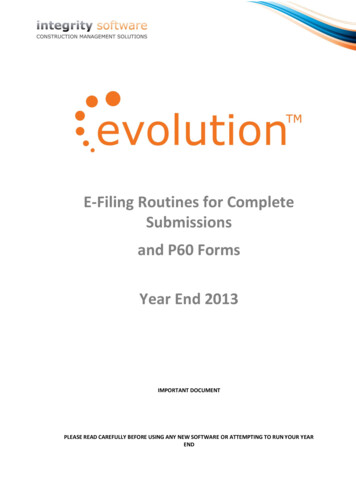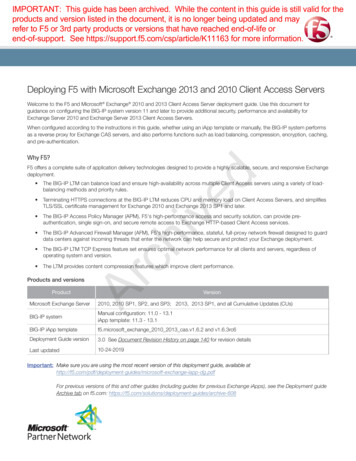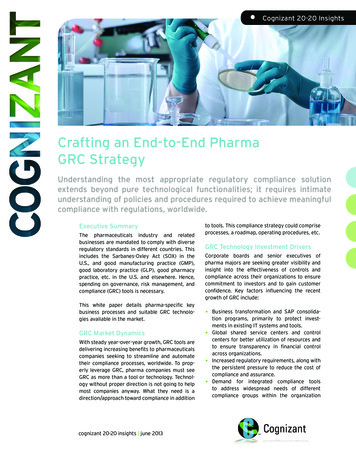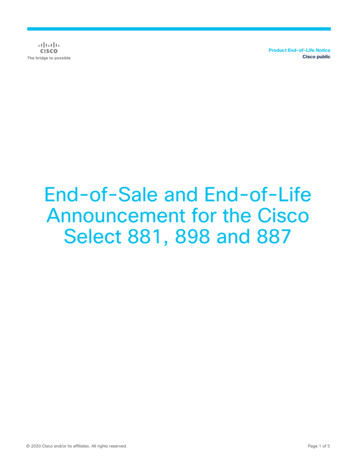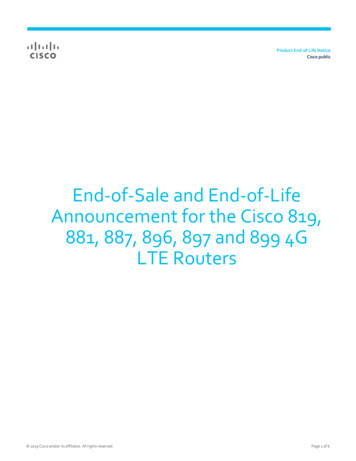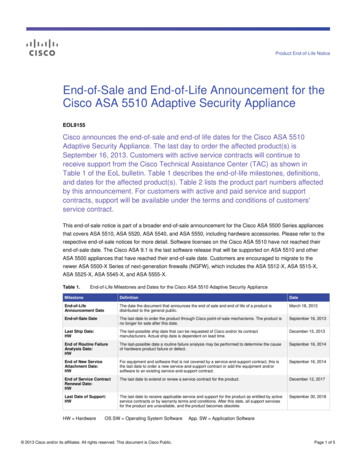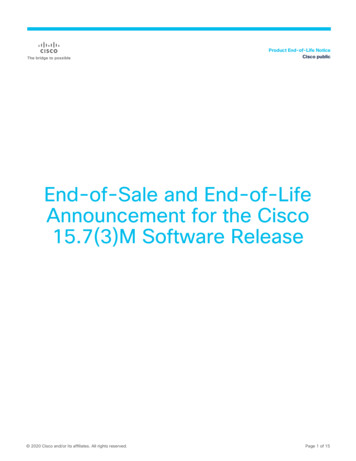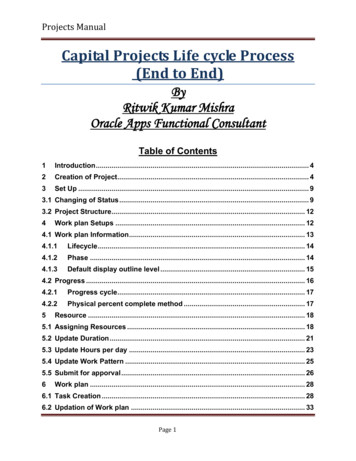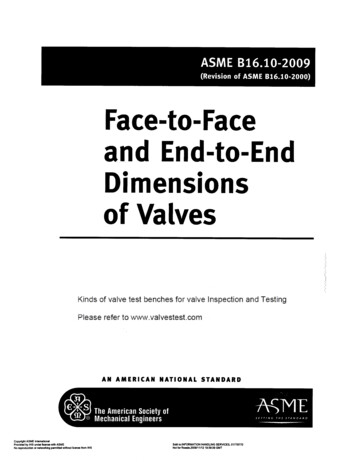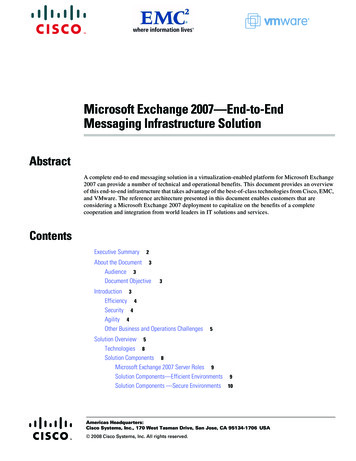
Transcription
Microsoft Exchange 2007—End-to-EndMessaging Infrastructure SolutionAbstractA complete end-to end messaging solution in a virtualization-enabled platform for Microsoft Exchange2007 can provide a number of technical and operational benefits. This document provides an overviewof this end-to-end infrastructure that takes advantage of the best-of-class technologies from Cisco, EMC,and VMware. The reference architecture presented in this document enables customers that areconsidering a Microsoft Exchange 2007 deployment to capitalize on the benefits of a completecooperation and integration from world leaders in IT solutions and services.ContentsExecutive Summary2About the Document 3Audience 3Document Objective3Introduction 3Efficiency 4Security 4Agility 4Other Business and Operations Challenges5Solution Overview 5Technologies 8Solution Components 8Microsoft Exchange 2007 Server Roles 9Solution Components—Efficient Environments 9Solution Components —Secure Environments 10Americas Headquarters:Cisco Systems, Inc., 170 West Tasman Drive, San Jose, CA 95134-1706 USA 2008 Cisco Systems, Inc. All rights reserved.
OL-17737-01Executive SummarySolution Components—Agile Environments11Solution Details 12Solutions for Microsoft Exchange 2007 12Sizing and Performance Management for ExchangeResiliency and Availability 20Disaster Recovery 24Security 27Management 28Conclusion29References30Appendix A—Microsoft Exchange Server 2007 OverviewMicrosoft Exchange 2007 Server Roles 31Client Access Server 31Hub Transport Server 32Mailbox Server 32Edge Transport Server 321531Executive SummaryMicrosoft Exchange messaging environments support a vital part of a company’s operation where usersexpect to have access to the messaging system at all times. Microsoft Exchange messaging environmentsare also growing in complexity and user requirements are increasingly demanding. Additionally, themanner in which Microsoft Exchange is used to support business operations has changed and it is noweven more business-critical than ever before.Without a comprehensive plan for a Microsoft Exchange 2007 deployment, the company could face: Loss of revenue Missed business opportunities Compliance-related fines Loss of dataWith these potential risks of a poorly implemented solution, our market analysis revealed the followingcritical business factors that affect Microsoft Exchange 2007 installations: Capital cost reduction through consolidation Operating expense reduction through streamlining operations management Risk reduction through validated compliance Risk reduction through security (including spam and virus filtering needs)Microsoft Exchange 2007—End-to-End Messaging Infrastructure Solution2OL-17737-01
OL-17737-01About the DocumentCisco, EMC, and VMware developed a jointly validated foundation reference architecture for MicrosoftExchange 2007 to address these requirements, offering organizations the building blocks to takemessaging to the next level. Implementing the joint reference architecture for Microsoft Exchangeensures the resiliency to meet the growing demands of today's rapidly changing business.About the DocumentAudienceThis document is intended for Cisco, EMC, and VMware customers. In addition, this document benefitsMicrosoft Exchange administrators and architects, systems administrators, systems architects, andanyone involved in the design, decision making, and implementation of a Microsoft Exchange 2007solution would find this paper useful.Document ObjectiveThe objective of this document is to provide customers an overview of the joint Cisco, EMC, andVMware solution for Microsoft Exchange 2007 messaging infrastructures. It is not meant to introducethe reader to basic EMC, VMware, or Cisco data center; nor is it meant to be a resource to learn thedetails of Microsoft Exchange Server 2007.IntroductionMicrosoft Exchange is considered the backbone of enterprise messaging environments and is growing ata rapid pace. As the number of users and departments grow, so does the requirement for a scalable,reliable, and cost effective Microsoft Exchange architecture to meet the new business requirements.While enterprises prepare to meet demands for greater collaboration, quicker access to applications andcompliance with ever-stricter regulatory compliance, they are being crimped by issues relating to powerand cooling, efficient asset utilization, escalating security and provisioning needs, and businesscontinuance. Customers understand that unmanaged growth is no longer viable and appreciate thebenefits that are gained from data center consolidation and virtualization. A virtualized data centerinfrastructure enables the customer to efficiently service an Microsoft Exchange collaborativeenvironment.Cisco, EMC, and VMware are jointly collaborating on a validated solution for an end-to-end messaginginfrastructure in a fully virtualized architecture (see Figure 1). The design presented in this documentenables customers considering a Microsoft Exchange 2007 deployment to capitalize on the benefits of avirtualized platform with VMware ESX 3.5, EMC storage and replication capabilities that providedisaster-recovery protection, and advanced server and storage connectivity through Cisco technology.The combination of these technologies provides a critical combination for efficient, secure, and agiledeployments that achieve the business initiatives stated earlier under Executive Summary, page 2.Microsoft Exchange 2007—End-to-End Messaging Infrastructure SolutionOL-17737-013
OL-17737-01IntroductionVirtualized End-to-End Messaging InfrastructureEfficientSupport the continuedgrowth in information whilereducing the number andcost of resources requiredto meet service levelsSecureAgileReduce risk by assuringaccess to informationacross the infrastructurewhile protecting it fromloss or misuseIncrease effectiveness byenabling the informationinfrastructure to adapt tochanging business needs225079Figure 1EfficiencyEnterprise customers need to support the continued growth in data while consolidating assets andreducing costs. Many customers today are also facing imposed or adopted "green" initiatives and arelimited in the amount of power and cooling they can consume. At the same time, managing moreinformation, providing sufficient application performance, and enabling access to information forcompetitive advantage means building infrastructures that are more efficient than ever before.SecurityDue to recent high-profile security breaches and identity thefts, governments and security agenciesworld wide have introduced security regulations such as the the Health Insurance Portability andAccountability Act (HIPAA), Sarbanes-Oxley, Basel II, and European Privacy Directive to protectsensitive data. The loss of sensitive data raised security concerns about how data has been stored orforwarded across the enterprise, including Microsoft Exchange email messages. The concerns includetheft of disk drives, backup tapes lost during transportation, hacking, and access control. Nearly allcustomers today need to protect huge volumes of information from loss and from falling into the wronghands. The next generation of the information infrastructure needs to provide end-to-end securesolutions.AgilityCustomers demand high service velocity to adapt to their ever-changing business environments. Avirtualized environment reduces the time to service customers, whether it is adding new storage oradding new servers to support growth. Efficiency and security are not enough. Customers need theirinformation infrastructure to be agile enough to respond quickly to changing business needs and servicelevels.Microsoft Exchange 2007—End-to-End Messaging Infrastructure Solution4OL-17737-01
OL-17737-01Solution OverviewOther Business and Operations Challenges Growth of information makes day-to-day information and infrastructure management more difficultand costly. Operational risks are increasing. Increasing data migration requirements necessitates the ability to move data between heterogeneousarrays nondisruptively, even in mission-critical environments. Businesses must optimally use the server resources already deployed without purchasing additionalhardware. Customers need secure data, whether on a storage device or in real time. Regulatory requirements for data availability and data replication must be met. Businesses need a backup to remote business continuity sites more than 150 miles away. The cost for dark fiber connectivity is prohibitive. Businesses must protect their network application services. Large consolidated storage area networks (SANs) offer improved consolidation economics, but canbe difficult to manage, secure, and keep available. Corporate information "at the edge" is difficult to manage, protect, and share. Local recovery must be simplified: These files can be backed up and restored in order to recover theserver if a host fails or a system becomes corrupted. The backup is often performed through aSAN-based copy or snap technology that allows for very quick recovery of the server on the sameor alternate hardware.Solution OverviewMicrosoft Exchange 2007 provides a solid foundation for corporate messaging. However, due to highavailability requirements of ever-increasing email data, the need to archive and provide mobilityservices, and protect email against intended or unintended threats makes it necessary to provide a holisticapproach to a company's solution. A piecemeal approach can be overly complicated and difficult tomaintain and manage. With EMC, VMware, and Cisco's foundation architecture for Microsoft Exchange2007, organizations have the building blocks to ensure that the growing demands of today's rapidlychanging landscape are met while protecting capital investments for years to come.Figure 2 depicts the high level services that Cisco, VMware, and EMC provide.Microsoft Exchange 2007—End-to-End Messaging Infrastructure SolutionOL-17737-015
OL-17737-01Solution OverviewFigure 2Cisco, VMware, and EMC ervicesSPAM/Virus bal SiteSelectionServer LoadBalancingIP NetworkMetro/Wide AreaNetworkIP NetworkUnified I/OLocal SiteVirtualized MB rvicesThis Microsoft Exchange messaging infrastructure solution is built upon elements of virtualizationincluding server, storage, and network components that can simplify management and enableconsolidation of physical assets and rapid provisioning of heterogeneous resources. It can also addressother applications such as Structured Query Language (SQL) and Microsoft Office SharePoint Services(MOSS), because the solution can decouple applications from the hardware infrastructure. Within thissolution Cisco, EMC, and VMware also address high availability and disaster-recovery requirements.EMC offers a variety of storage products and capabilities that enable highly scalable solutions for everysize deployment from very small mailboxes to enterprise-level environments in various topologies andcapacity options, enabling you to plan for any size mailbox deployment and absorb unpredictable mailgrowth that is a growing challenge. Advance storage capability is an essential part for the design ofMicrosoft Exchange mailbox and database architectural components.As mentioned previously, Cisco, EMC, and VMware can achieve asset usage at various levels andcomponents. From a server perspective and consolidation point of view, VMware's capability in serverconsolidation can achieve compelling usage ratios by enabling the creation of multiple virtual machineswithin one physical server and aligning the right resources with the projected workload, such as CPU ormemory draining services from specific server roles in the infrastructure.Microsoft Exchange 2007—End-to-End Messaging Infrastructure Solution6OL-17737-01
OL-17737-01Solution OverviewIn Exchange 2007, Microsoft introduced multiple server roles that provide different functions. In somecases some of these server roles require more resources to run their function than others. With VMwareserver virtualization, we can provide a methodology of server consolidation into fewer physical serverentities, eliminating much needed real state within the data center and alleviating cooling, energy, andenvironmental data center requirements. This methodology is also ideal for the various Microsoft ActiveDirectory servers.High availability (HA) is another aspect being addressed through server virtualization. With VMwareHA if a host fails, the host's virtual machines are brought back online by another host in the environment.VMware HA is an ideal way to protect the virtual server farm because this functionality can be extendedto any Exchange server role, whereas in the past the traditional approach was to protect only the mailboxserver.In addition to server high availability, this solution also addresses information availability and mail storerecovery with Virtual Switching System (VSS) technology. The EMC Replication Manager is EMC'sleading VSS requestor; it provides online replication for Microsoft Exchange 2007 and an automatedrecovery process. Both the replication and recovery process fully adhere to an application programminginterface (API) framework provided by Microsoft, which ensures proper mechanisms of replication andrecovery.With array-based replication, the recovery of Exchange databases can be performed in just minutes.Regardless of the size of the mailbox database, customers are able to provide server uptime within verystrict service-level agreements (SLAs). In this solution, the storage has been designed to hold two fulldays worth of data on disk at all times. This means that 48 hours of data is available on high-speed diskat all times. When data older than 48 hours is required, restore from tape is used. The ReplicationManager is primarily used for mailbox database recovery purposes, where corruption may have been thecause for the down condition.EMC's Replication Manager can replicate Exchange environments in a physical environment as well asin a virtual configuration. A functionality like Vmotion provides the ability to move virtual machinesfrom one physical server to another physical server. Replication Manager is able to adjust its replicationpolicies and continue to replicate these environments regardless of the virtual machine movement.As mentioned previously, email messaging has become a mission-critical application, and this solutionprovides an advance disaster-recovery capability by combining EMC's RecoverPoint, which providesarray-to-array replication across extended distances, taking advantage of the Cisco MDS 9000 StorageServices Module (SSM). The SSM module provides compelling capability in data-splitting technology,allowing a customer to capture data in both the source and target sites.RecoverPoint introduces two options of protection: Continuous Data Protection (CDP), which allows customers to capture frequent snapshotsbookmarks ) of their environment for local data recovery Continuous Remote Replication (CRR) , which replicates data from array to array across extendeddistanceThese two modes can be combined and, for the first time, customers are able to provide restart of servicesat a disaster-recovery location as well as recovery of data in case of corruption or data loss. Furthermore,RecoverPoint has extended its compelling data replication capability by integrating its replication enginewith VMware's Site Recovery Manager, which provides full automation of the restart process at thedisaster-recovery site for all virtual machines and applications being failed over. This key feature ofautomation provides additional value by removing human-error factors in a disaster event, as all policieshave been predefined and can be tested by simulating these events before a disaster occurs.Many of the components mentioned in the solution so far rely heavily on a solid infrastructure that canprovide advance connectivity regardless of the topology and protocol. Cisco Fiber Channel directorsprovide all the high-performance connectivity needed for these critical environments.Microsoft Exchange 2007—End-to-End Messaging Infrastructure SolutionOL-17737-017
OL-17737-01Solution OverviewTechnologies Cisco, EMC, and VMware continue to partner closely to develop key network-storage capabilitiesin support of virtualized environments Cisco is also a major investor in VMware and such continues to partner closely to develop keynetwork-server capabilities in support of virtualized environments. Cisco and EMC: Technology collaboration and integration into Cisco MDS platform Cisco Server Load Balancing (SLB), Secure Sockets Layer (SSL) Offload, and connectionmanagement Cisco: VN-Link, Virtual Switch for enhanced VM capabilities, and management Cisco: Fibre Channel over Ethernet for enhanced server flexibility Cisco: MDS/SSM/SANTap Cisco perimeter and application security solutions such as ASA Firewalls and Cisco/IronPort spam,Malware, and Data Loss Prevention (DLP) filtering Cisco: MDS VSAN technology Cisco: Wide Area Application Services (WAAS) EMC CLARiiON CX3-80 storage technology EMC VSS requestor Replication Manager EMC RecoverPoint which provides for advanced data replication RSA: Key Manager EMC: Connectrix MDS EMC: Qualification and support EMC: RecoverPoint VMware Infrastructure with VMotion, high availability (HA), business continuity (BC), andDynamic Resource Scheduler (DRS)Solution ComponentsThis section describes the objectives and characteristics of the architecture. Cisco, EMC, and VMwarehave developed a reference architecture that addresses the following business needs: Reduction of cost with virtualized end-to-end infrastructure and unified I/O Increased operational efficiencies through rapid storage provisioning services, bandwidthoptimization services, and intelligent SLB services Meeting or exceeding compliance mandates with security services and clearly defined andachievable Recovery Point Objectives (RPOs) and Recovery Time Objectives (RTOs) Drastic reduction in unwanted spam and virusesThis section discusses the Microsoft Exchange Server 2007 roles and provides high-level informationabout the EMC, VMware, and Cisco product and solution components that provide an efficient, secure,and agile messaging environment.Microsoft Exchange 2007—End-to-End Messaging Infrastructure Solution8OL-17737-01
OL-17737-01Solution OverviewMicrosoft Exchange 2007 Server RolesMicrosoft Exchange Server 2007 uses a variety of roles to provide services. Some roles are the same orslightly different from the roles in Microsoft Exchange Server 2003, whereas others are new. Each roleserves a unique purpose within the Microsoft Exchange architecture and is flexible enough to bedeployed in various sizes of organizations with varying requirements.Some roles can be installed together on a single platform or deploy them completely independent of oneanother. Small and medium-sized businesses can take advantage of the diverse number of MicrosoftExchange Server 2007 features while limiting the amount of hardware required for deployment. Largeorganizations can take advantage of the ability to deploy multiple roles in a redundant fashion onindependent hardware platforms in geographically dispersed locations.The following Microsoft Exchange Server 2007 roles are discussed in this document: Client Access Server (CAS) provides messaging access to a variety of client endpoints to includeOutlook Web Access (OWA), Outlook Anywhere, and ActiveSync clients. Hub Transport (HT) performs the central role for all intelligent message routing, delivery, andcontrol within and outside of the organization. Mailbox Server (MBX) ) is the database for all user messaging data; it provides access to MessagingApplication Programming Interface (MAPI)-based clients such as Outlook. Edge Transport (ET) provides Inter
Microsoft Exchange 2007—End-to-End Messaging Infrastructure Solution OL-17737-01 OL-17737-01 About the Document Cisco, EMC, and VMware developed a jointly valida ted foundation reference architecture for Microsoft Exchange 2007 to address these requirements, offering organizations the building blocks to take messaging to the next level.
